In an astounding feat inside the caves of Meghalaya along with members of Meghalaya Adventures Association and Irish Cave Rescue Operations, Patricia Mukhim accounts a firsthand experience at it while providing an in-depth interpretation of caving as well as rescue operations.
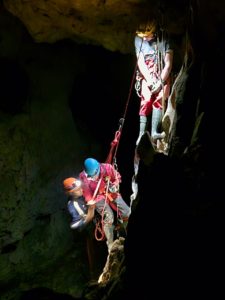 Caving is one of the most exhilarating experiences for those with a quest for adventure. For Brian Kharpran Daly (founder of the Meghalaya Adventurers Association (MAA), caving has become a mission to save the caves of Meghalaya many of them being limestone caves which are under grave threat from reckless mining activities and no eco-restoration plans in place. Interesting fact: the Mawmluh cave (Krem Mawmluh) in Sohra was studied by the California team of geologists in 2003 led by Ashish Sinha from California who studied the cave and later researcher Sebastian Breitenbach joined the team. After analysing stalagmites of Krem Mawmluh, it finally resulted in coining the new geological time ‘Meghalayan Age’.
Caving is one of the most exhilarating experiences for those with a quest for adventure. For Brian Kharpran Daly (founder of the Meghalaya Adventurers Association (MAA), caving has become a mission to save the caves of Meghalaya many of them being limestone caves which are under grave threat from reckless mining activities and no eco-restoration plans in place. Interesting fact: the Mawmluh cave (Krem Mawmluh) in Sohra was studied by the California team of geologists in 2003 led by Ashish Sinha from California who studied the cave and later researcher Sebastian Breitenbach joined the team. After analysing stalagmites of Krem Mawmluh, it finally resulted in coining the new geological time ‘Meghalayan Age’.
Recently, Daly had accompanied the scientists from California to Krem Mawmluh, wherein, MAA in collaboration with the Irish Cave Rescue Operations (ICRO) undertook a weeklong training on cave rescue at Krem Wallang in Byrong village under the Wahlong Sirdarship. The trainees included younger members of the MAA and other interested cavers from local universities, led by Shelley Alexandra Diengdoh (SD).
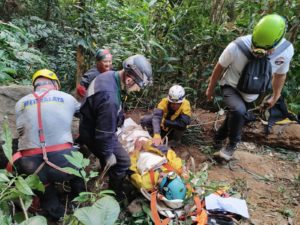 From a first-hand experience, I was first lowered into the cave with carefully fitted straps to have a real time experience of what a rescue mission inside a cave actually entails. Needless to say, it was an experience of a lifetime while exiting the cave through a hole that one thought one could barely force one’s way through but it was made possible under the able hands of the Irish gentlemen. Inside the cave, the calcite shimmered in the darkness even as each caver had a helmet with lights on. The rooms inside the cave were huge and the fossils decorating the cave walls were simply breathtaking.
From a first-hand experience, I was first lowered into the cave with carefully fitted straps to have a real time experience of what a rescue mission inside a cave actually entails. Needless to say, it was an experience of a lifetime while exiting the cave through a hole that one thought one could barely force one’s way through but it was made possible under the able hands of the Irish gentlemen. Inside the cave, the calcite shimmered in the darkness even as each caver had a helmet with lights on. The rooms inside the cave were huge and the fossils decorating the cave walls were simply breathtaking.
After such an experience, Sunday Shillong engaged with Diengdoh to get more insights into the world of caving and rescue missions:
SS: How old is the Meghalaya Adventurers Association(MAA) and what are the objectives? Who were the founding members of the Association?
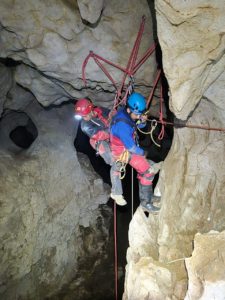 SD: The MAA was founded in the year 1990 and started its cave exploration and related activities in 1992. The Association was founded by Brian Kharpran Daly and Donbokwell Syiemlieh with the prime objective to promote all types of adventure activities amongst the youth of the state.
SD: The MAA was founded in the year 1990 and started its cave exploration and related activities in 1992. The Association was founded by Brian Kharpran Daly and Donbokwell Syiemlieh with the prime objective to promote all types of adventure activities amongst the youth of the state.
The cave exploits of Huckleberry Finn in a cave had excited the young mind of Brian at an early age This resulted in his exploration of a cave in December 1964 during a school picnic in Mawsmai. The embers never died until it sparked to life in 1992. Since then much water has flowed and much of the underground world has been unearthed.
SS: Is this the first time the MAA is involved in training its members in rescue ops for injured cavers?
SD: With the rising popularity of cave tourism in the state and unregulated safeguards not in place, mishaps are bound to happen. With this in view, the MAA felt that it was incumbent on it to train its members to meet such eventualities. A seven member group was sent to the UK for SRT(Single Rope Technique) and to The Republic of Ireland for a specialized cave rescue training under the Irish Cave Rescue Organization ( ICRO).
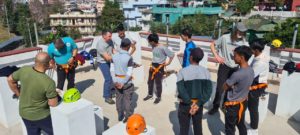 SS: Recently the MAA partnered in joint rescue training operations with the ICRO at Krem Wallang in Byrong village, under Wahlong Sirdarship adjacent to the Wahrew River. How was your experience of the one week rescue training ops with the Irish cavers?
SS: Recently the MAA partnered in joint rescue training operations with the ICRO at Krem Wallang in Byrong village, under Wahlong Sirdarship adjacent to the Wahrew River. How was your experience of the one week rescue training ops with the Irish cavers?
SD: To be frank our team which also included trainees from Martin Luther Christian University were excited to be trained by some of the world’s best experienced rescue team members. It was awe inspiring especially for me as a woman. The skills of the training team (ICRO) are so thorough and meticulous and left no margin for error whatsoever.
SS: When did the MAA get the cave rescue ops training in Ireland? How was the experience? What is the difference between caves here and there?
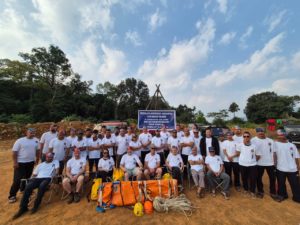 SD: The MAA got the cave rescue ops training in the Republic of Ireland in 2023 in the month of July – August. This was followed by the MAA in the first cave rescue exercise in the month of November 2023 in Mawmluh cave and another joint exercise with the different departments of the Government of Meghalaya in March 2024.
SD: The MAA got the cave rescue ops training in the Republic of Ireland in 2023 in the month of July – August. This was followed by the MAA in the first cave rescue exercise in the month of November 2023 in Mawmluh cave and another joint exercise with the different departments of the Government of Meghalaya in March 2024.
The recent advanced cave rescue training by the ICRO has elevated the expertise of the MAA to a higher level.
Caves are more or less the same anywhere except in the composition of the rocks or the temperature of the region. The caves of Meghalaya hold a unique place as they are amongst the best in the world. Meghalaya has been firmly entrenched on the world cave map.
SS: How did you manage to supervise the entire rescue training? When and how did you develop an interest and passion for caving?
SD: Being well versed in the basics and being trained by dedicated and highly experienced cave rescue trainers, I picked up the confidence as naturally as I was born with it. Based on my skills I was made the overall coordinator of the cave rescue exercise to oversee the entire surface and underground rescue operation, which I think is an achievement and an honour.
I was always interested in adventure and I had the opportunity to accompany my father, Daly on his cave explorations in 1997. Since then I’ve never looked back.
SS: What is MAA’s message to Meghalaya cavers in general and to national and international cavers?
SD: Our message to all cavers is, be adventurous and develop your passion seriously. Never look back. Obstacles should never obstruct your path.
—End of Interview—
Meanwhile Brían MacCoitir, the team leader of ICRO while speaking to Sunday Shillong said, “I made my first trip to Meghalaya with the annual international caving expedition in 2003 and I’ve been over a number of times since. This was my introduction to Brian Daly and the larger local team.” Talking about the caves of Meghalaya, MacCoitir says, “The caves of Meghalaya have proven to be world class. There is great variety in the type of caves from clean water washed passage to high level fossilised chambers. There are both lengthy horizontal passages as well as deep vertical shafts. The caves have held many secrets over the centuries including a number of species found only in this region. The quest to discover these secrets keeps bringing me back to Meghalaya.”
Like all ardent cave lovers, MacCoitir too feels very strongly about the need to prevent reckless exploitation of the limestone caves. He feels that in order to preserve or conserve the caves and their unique environments, caves should be given special status by legislation for conservation in planning. “Mining and quarrying are the biggest threats. Education related to caves in the broadest sense is the surest way to garner public support to protect the caves.”
Speaking about the trainees who attended the cave rescue training, MacCoitir said they were enthusiastic to learn new skills and quick to grasp the principles involved. However as there has only been a few weeks instruction delivered, the journey to becoming a fully competent cave rescue team has only just begun. “Many more skills and knowledge are yet to be grasped. With the contacts made, ICRO are committed to supporting the MAA on their journey,” he adds.
Speaking about the ICRO team structure, MacCoitir explained that the team comprises a chairman and committee that provides support to the regional wardens and core team of 50 members that make up the national team. “Of the 8 members of ICRO that were in Meghalaya, 5 are regional rescue wardens and 2 were former ICRO national chairmen including myself” says MacCoitir.
Stating that cave rescue is a specialised activity requiring a very specific set of skills and competencies, MacCoitir says that cave rescuers are aware that in all likelihood, when called upon, they may have to rescue a fellow caver. That person could be someone they may know and have done caving with previously. “That takes a very particular mindset considering the challenges. It is very satisfying to be able to instill the resilience required in the Meghalaya cave rescue trainees,” an enthusiastic MacCoitir observed, adding that while cave rescue incidents are rare with the average incident lasting in the region of 18 hours, ICRO generally responds to between 5 to 10 incidents a year.
MacCoitir further informs that rescue operations are almost exclusively on the island of Ireland but he also said that the ICRO diving officer was one of the 6 divers that rescued the wild boar football team in Thailand that got the attention of the world.
Explaining their association with MAA MacCoitir said, “ICRO were proud to respond to the MAA request to provide cave rescue training for their members. This request could have been made to any of the many national cave rescue teams whose members have visited Meghalaya over the years but they reposed their faith in us,” adding that when the 7 MAA members visited Ireland in August 2023, they were presented with information on organisation as well as cave rescue techniques.
MacCoitir says it is imperative to set up an Indian cave rescue organisation to ensure an effective cave rescue capability. This organisation has to be set up on a formal basis with links to the many other statutory and voluntary rescue and emergency response bodies required to provide assistance in the event of a cave rescue incident.



